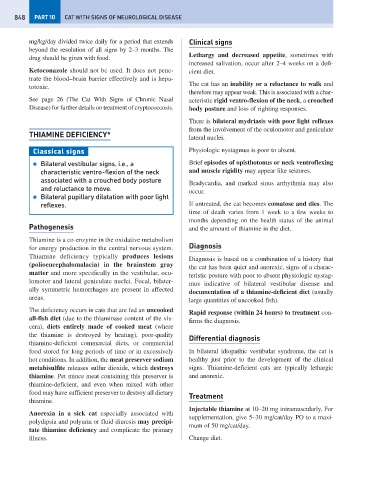Page 856 - Problem-Based Feline Medicine
P. 856
848 PART 10 CAT WITH SIGNS OF NEUROLOGICAL DISEASE
mg/kg/day divided twice daily for a period that extends Clinical signs
beyond the resolution of all signs by 2–3 months. The
Lethargy and decreased appetite, sometimes with
drug should be given with food.
increased salivation, occur after 2–4 weeks on a defi-
Ketoconazole should not be used. It does not pene- cient diet.
trate the blood–brain barrier effectively and is hepa-
The cat has an inability or a reluctance to walk and
totoxic.
therefore may appear weak. This is associated with a char-
See page 26 (The Cat With Signs of Chronic Nasal acteristic rigid ventro-flexion of the neck, a crouched
Disease) for further details on treatment of cryptococcosis. body posture and loss of righting responses.
There is bilateral mydriasis with poor light reflexes
from the involvement of the oculomotor and geniculate
THIAMINE DEFICIENCY*
lateral nuclei.
Classical signs Physiologic nystagmus is poor to absent.
● Bilateral vestibular signs, i.e., a Brief episodes of opisthotonus or neck ventroflexing
characteristic ventro-flexion of the neck and muscle rigidity may appear like seizures.
associated with a crouched body posture
Bradycardia, and marked sinus arrhythmia may also
and reluctance to move.
occur.
● Bilateral pupillary dilatation with poor light
reflexes. If untreated, the cat becomes comatose and dies. The
time of death varies from 1 week to a few weeks to
months depending on the health status of the animal
Pathogenesis and the amount of thiamine in the diet.
Thiamine is a co-enzyme in the oxidative metabolism
for energy production in the central nervous system. Diagnosis
Thiamine deficiency typically produces lesions
Diagnosis is based on a combination of a history that
(polioencephalomalacia) in the brainstem gray
the cat has been quiet and anorexic, signs of a charac-
matter and more specifically in the vestibular, ocu-
teristic posture with poor to absent physiologic nystag-
lomotor and lateral geniculate nuclei. Focal, bilater-
mus indicative of bilateral vestibular disease and
ally symmetric hemorrhages are present in affected
documentation of a thiamine-deficient diet (usually
areas.
large quantities of uncooked fish).
The deficiency occurs in cats that are fed an uncooked
Rapid response (within 24 hours) to treatment con-
all-fish diet (due to the thiaminase content of the vis-
firms the diagnosis.
cera), diets entirely made of cooked meat (where
the thiamine is destroyed by heating), poor-quality
Differential diagnosis
thiamine-deficient commercial diets, or commercial
food stored for long periods of time or in excessively In bilateral idiopathic vestibular syndrome, the cat is
hot conditions. In addition, the meat preserver sodium healthy just prior to the development of the clinical
metabisulfite releases sulfur dioxide, which destroys signs. Thiamine-deficient cats are typically lethargic
thiamine. Pet mince meat containing this preserver is and anorexic.
thiamine-deficient, and even when mixed with other
food may have sufficient preserver to destroy all dietary
Treatment
thiamine.
Injectable thiamine at 10–20 mg intramuscularly. For
Anorexia in a sick cat especially associated with
supplementation, give 5–30 mg/cat/day PO to a maxi-
polydipsia and polyuria or fluid diuresis may precipi-
mum of 50 mg/cat/day.
tate thiamine deficiency and complicate the primary
illness. Change diet.

